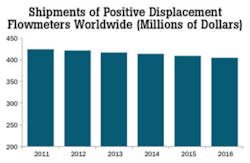Positive-Displacement Flowmeters: A Proven Solution for a Wide Range of Applications
Positive-displacement (PD) flowmeters are truly a member of the class of traditional technology flowmeters. Their history goes back to 1815, when Samuel Clegg invented the first PD gas flowmeter. This was a water-sealed rotating drum meter. Clegg’s son-in-law, John Malam, together with Samuel Crosley, invented an improved model in 1825. Problems remained, however, primarily in the form of high cost, freezing, and large size.
Thomas Glover invented the first “dry” gas diaphragm meter in 1843. Glover’s meter contained two diaphragms and a sliding valve. In 1844, the first actual dry gas meter was developed by engineers Croll & Richards. The diaphragm meters used today are similar to these early meters, although major improvements have been made in material of construction. Early meters had diaphragms made of sheepskin with steel metal enclosures. More recent meters have synthetic rubber-on-cloth diaphragms and are made of cast aluminum.
PD flowmeters are highly accurate meters used that are widely used for custody transfer applications, such as the exchange of commercial and industrial water. They are also used for custody transfer of hydrocarbon liquids to and from delivery trucks. PD flowmeters have the advantage of approval by a number of regulatory bodies for the purpose custody transfer, and they have not yet been displaced by other meter types. PD flowmeters are also used for the custody transfer of natural gas.
READ ALSO: Quiz Corner: PD Flowmeter Sizing
Bopp & Reuther (www.bopp-reuther.de) of Germany holds the earliest patent for the oval gear meter in 1932. This meter has since been popularized by Oval Corporation (www.oval.co.jp) of Japan, which introduced the oval gear meter in the early 1950s. Oval gear meters are used for liquid measurement.
Some relatively new developments focus on improved methods to increase the precision with which components are manufactured. For example, improved coordinate measuring machines make it possible to create more perfectly round pistons and other components. And as is the case with turbine flowmeters, improved bearing technology is making ball bearings more reliable and less prone to fail.
One major growth factor for positive-displacement flowmeters is the large installed base worldwide. Because they were introduced more than 100 years before new-technology meters. Installed base is a relevant growth factor because often when ordering flowmeters, especially for replacement purposes, users often replace like with like. The investment in a flowmeter technology is more than just the cost of the meter itself. It also includes the time and money invested in training people how to install and use the meter. In addition, some companies stock spare parts or even spare meters for replacement purposes. As a result, when companies consider switching from one flowmeter technology to another, there is more than just the purchase price to consider. The large installed base of positive-displacement flowmeters worldwide will continue to be a source of orders for new and replacement meters.
Positive displacement meters are specified by approval bodies for use in custody transfer for utility measurement in residential, commercial, and industrial applications. These organizations include the American Water Works Association (AWWA, www.awwa.org) and the International Standards Organization (ISO, www.iso.org) in Europe. These approvals have been in place for many years. The AWWA has approvals for both nutating disc and oscillating piston meters. Magnetic flowmeters are starting to make inroads in this area, however.
Despite their advantages, PD flowmeters face competition from new-technology meters. In the area of oil flow measurement, PD meters face a stiff challenge from Coriolis meters. Because oil is a high-value product, end-users are more willing to pay the higher prices of Coriolis meters to measure its flow. PD meters are widely used to measure the flow of hydrocarbon products, especially downstream of refineries at custody-transfer points and for fiscal and utility measurements.
For more information on Flow Research’s work in the area of positive-displacement flow measurement, visit www.FlowPD.com.
Jesse Yoder
Jesse Yoder, Ph.D., is president of Flow Research Inc. He has 30 years of experience as an analyst and writer in instrumentation. Yoder holds two U.S. patents on a dual-tube meter design and is the author of "The Tao of Measurement," published by ISA. He may be reached at [email protected]. Find more information on the latest study from Flow Research, "The World Market for Gas Flow Measurement, 4th Edition," at www.gasflows.com.



